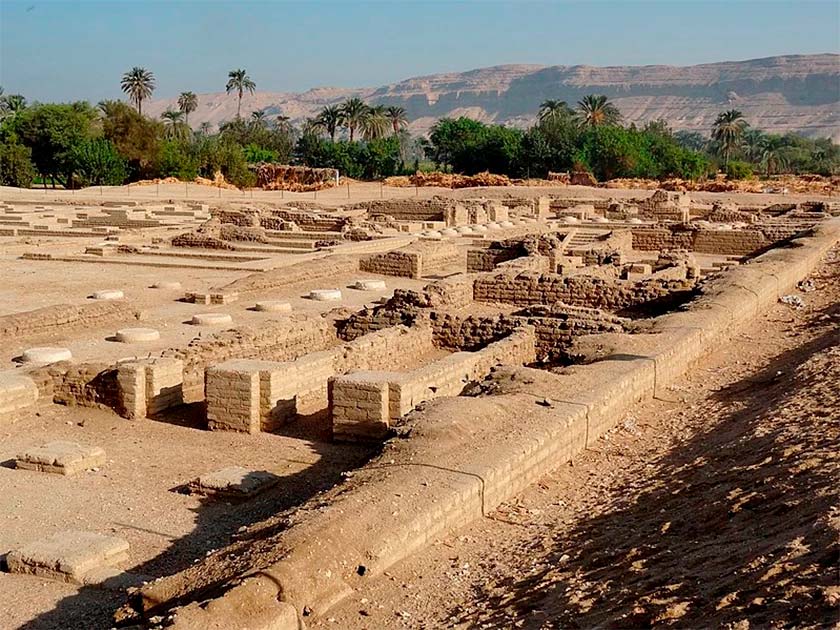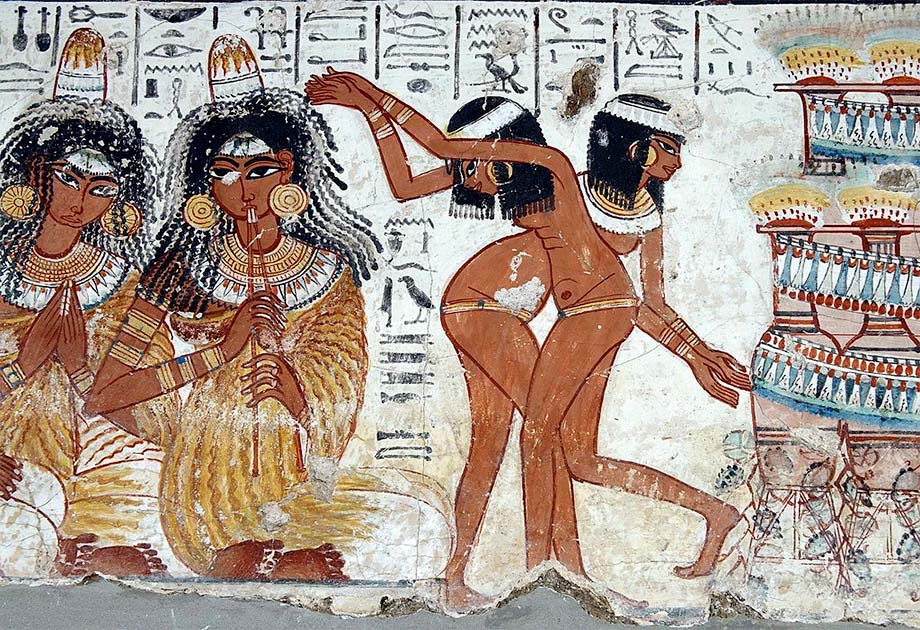Ancient Egypt was very kind to archaeologists. They lived in a very dry environment, perfect for preserving their dead, and they helpfully built monumental buildings in stone, covering the walls with their history.
To be sure, these monumental edifices which survive are only the peak of Egyptian architecture, with many more basic buildings lost to time. But what does survive is enough to give us more detail on the Egyptians than any other comparative civilization.
Amongst the answers however there are puzzles. One such comes from the repeating images of Egyptians with small, pointy cones over their heads. The men and women in these images are shown with head cones, depicted artistically.
These depictions were not just in images but also survive in papyrus scrolls, and on sarcophagi. These are obvious common and recognizable depictions, which would be well know to the Egyptians but which seem obscure to us.
These depictions of the pointy cones resemble that these objects were used in divine rituals and royal feasts. Women are depicted in images giving birth while wearing these pointy cones.
It seems that they are associated with specific gods. But, even though these head cones were common in all forms of Egyptian art for over 1,000 years, their existence and purpose were still a mystery.
That mystery has finally been solved now with the help of professional archaeologists with over years of research and analysis. At last we think we know what these are.
The Quest to Find the Ancient Egyptian Cone Heads
Initially, most scholars concluded that the Egyptian pointy head cones were just some form of symbolic representation. They assumed it to be the equivalent of the halos which appear on angels and saints within Christian iconography.
- Did the Egyptians Discover Artificial Light?
- Herodotus and the Lost Labyrinth of Egypt: Found at Last?
But this all changed recently when an international team of archaeologists found the first physical and real-life evidence for the head accessories of Egyptians. These were not just artistic representations of some abstract concept, they were very real.

This discovery came from the Amarna cemetery. It is the ancient Egyptian city, the temples of which are erected within the reign of Akhenaten, the Pharaoh who is thought to be Tutankhamun’s father.
It is reckoned that the rich and elite of this city made up around 10% of the population of 30,000 people in Amarna. The rich were buried in the opulent tombs, and others received modest burials.
The city was built in the 14th century BC and had significance for only 15 years, part of Akhenaten’s new religion which was quickly snuffed out after his death. In 2009, a project led by the University of Cambridge with funds from the National Geographic Society found the remains of Ancient Egyptian head cones.
This was a whole new discovery, different from that of the other burials. The pointy object in the excavated burial exactly matched that depicted in Egyptian art. Soon after, another discovery of a burial with the head cone confirmed the existence of these, not just in images but in reality as well.
What Were the Pointy Head Cones?
It took over a decade for scholars and authorities to analyze and examine the discoveries. Upon analysis of the funerary objects, it was found that the head cones were the solid lumps of perfumed fat. They were designed to be put on the wearer’s head and to melt over time. Hence, it served to be an ancient and fragranced hair gel.
On further research, it was proven that these pointy cones were carefully constructed, no mere blobs of grease. The cones were not solid but were hollow shells folded around brown and black organic matter. The research and analysis team believes it to be some form of fabric. The head cones discovered from the burial sites also had the chemical signatures of decayed wax.
The scholars concluded that these coneheads were made up of beeswax, the only biological wax reportedly used by the ancient Egyptians. Apart from that, no such wax traces were found even in the other most well-preserved skeletons.
It is said that an adult woman wore one of the discovered specimens of head cones. The scholars again suggested that the cones were connected to fertility by some means.
The problem with further research ideologies was that these coneheads were found in the non-elite cemetery, making it difficult to interpret the exact meaning of this assumption. As per the Egyptian iconography, it is said that the people who depicted the head cones were not just elite members of ancient Egypt. Some of them seem to be the servants of that time as well.
It is concluded so because the handful of images over the tombs of burials at the Amarna sites has people wearing these cones while preparing for burials or making the offerings. These cones are said to be worn during the presence of the divine in ancient Egypt. Different researchers and archaeologists had different theories for the head cones of these women.
Nicola Harrington, an archaeologist at the University of Sydney, said that these two discovered specimens might be the women dancers. Both of the specimens had critical spinal fractures, and one amongst the two also had a degenerative joint disease. The fractures were researched due to some form of stress and compression, which is common in professional dancers.

Harrington also says that, in ancient Egypt, the dancers were marked as the community members that intended to serve the gods. Hence, the cones could have been a type of mark for them! Therefore, Harrington believes that this is the theory behind why these two burials were not in the elite cemetery but were more basic burials that nevertheless included cones.
Archaeologists need more evidence to determine the true purpose of these cones. The professionals believe that there will be excavations of more head cones with the latest archeologically advanced techniques and implementations in the future.
With these two discoveries, a bit of a mystery associated with the pointy cones in ancient Egyptian art and images was solved. But this opens up the window to many buried stories that are still waiting to be discovered and told to the world.
Top Image: Userhet and his wife, from the famous Egyptian tomb of Userhet: all figures are depicted with head cones. Source: Norman de Garis Davies / Public Domain.
By Bipin Dimri